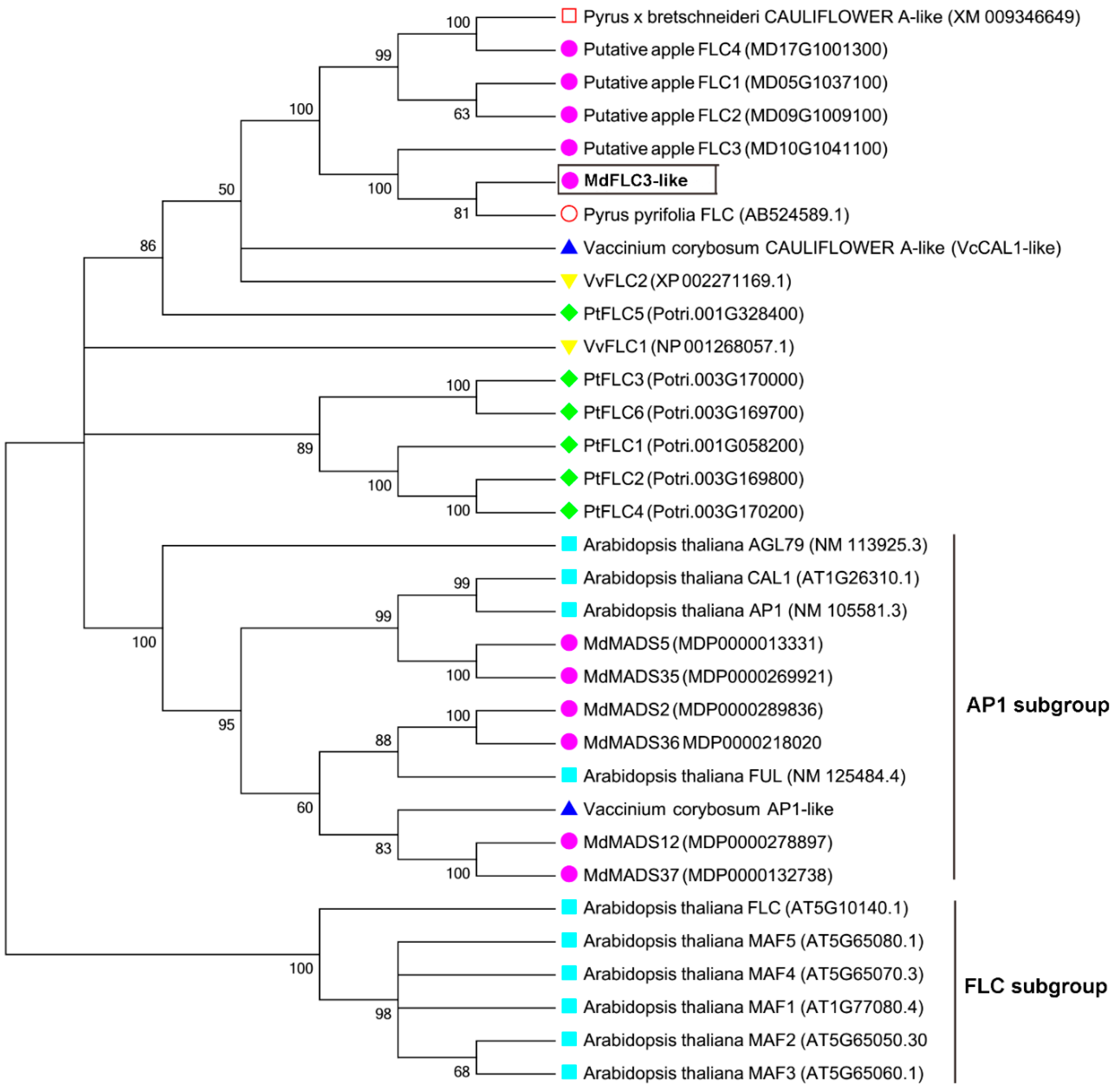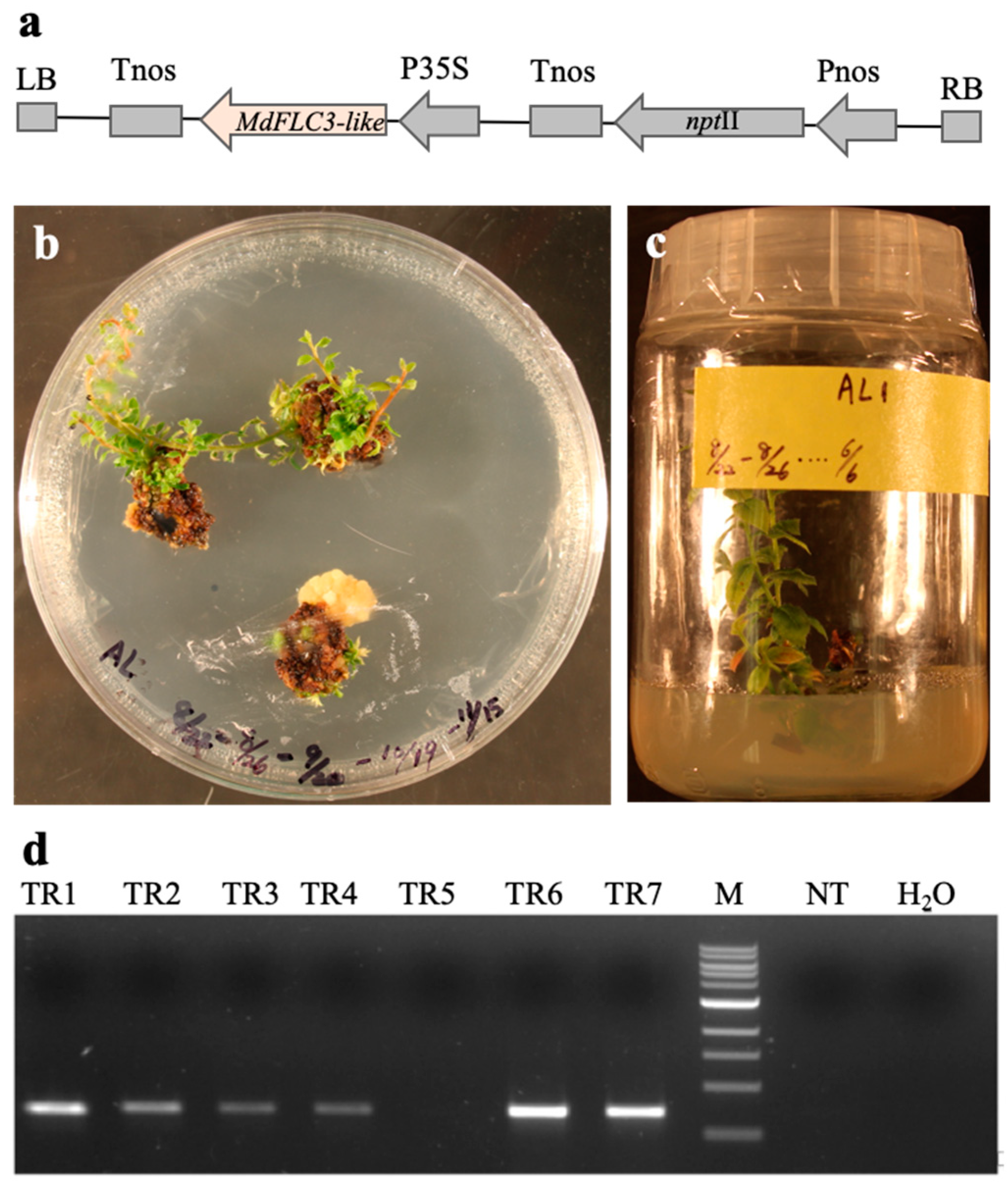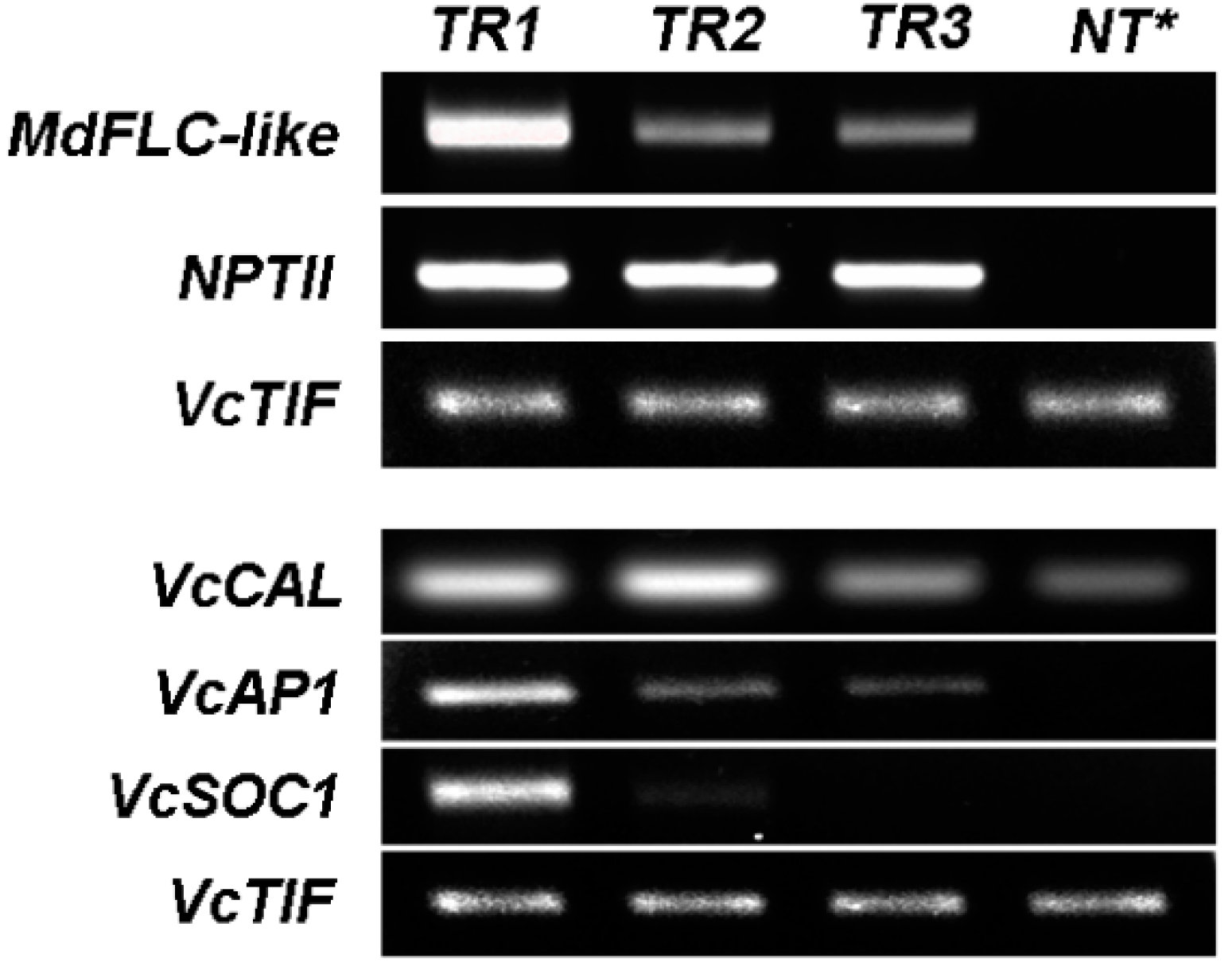Constitutive Expression of an Apple FLC3-like Gene Promotes Flowering in Transgenic Blueberry under Nonchilling Conditions
Abstract
:1. Introduction
2. Results
2.1. Isolation and Sequence Analysis of an MdFLC3-like Gene
2.2. Expression Levels of MdFLC3-like in Four Apple Tissues
2.3. Ectopic Expression of MdFLC3-like Promoted Flowering of Nonchilled Blueberry
2.4. Responses of Flowering Pathway Genes to the Constitutive Expression of MdFLC3-like
3. Discussion
3.1. A Functional FLC Orthologue in Woody Plants is Unknown
3.2. MdFLC3-like Does Not Function as an FLC in Blueberry
3.3. MdFLC3-like Likely Functions in a Positive Role in Flowering Initiation in Transgenic Blueberry
3.4. MADS-Box Genes Play Key Roles in Chilling-Mediated Flowering of Woody Plants
4. Material and Methods
4.1. Plant Material
4.2. MdFLC3-like Cloning and Phylogenetic Analysis
4.3. Quantitative Reverse Transcription PCR (RT-qPCR) Analysis
4.4. Construction of a MdFLC3-like Expression Vector
4.5. Transformation of 35S-MdFLC3-like to ‘Legacy’
4.6. Gene Expression Analysis of Transgenic ‘Legacy’
5. Conclusions
Author Contributions
Funding
Conflicts of Interest
References
- Amasino, R. Vernalization, competence, and the epigenetic memory of winter. Plant Cell 2004, 16, 2553–2559. [Google Scholar] [CrossRef] [PubMed]
- Jung, C.; Muller, A.E. Flowering time control and applications in plant breeding. Trends Plant Sci. 2009, 14, 563–573. [Google Scholar] [CrossRef] [PubMed]
- Henderson, I.R.; Dean, C. Control of Arabidopsis flowering: The chill before the bloom. Development 2004, 131, 3829–3838. [Google Scholar] [CrossRef] [PubMed]
- Levy, Y.Y.; Dean, C. The transition to flowering. Plant Cell 1998, 10, 1973–1989. [Google Scholar] [CrossRef] [PubMed]
- Bowman, J.L.; Alvarez, J.; Weigel, D.; Meyerowitz, E.M.; Smyth, D.R. Control of Flower Development in Arabidopsis-Thaliana by Apetala1 and Interacting Genes. Development 1993, 119, 721–743. [Google Scholar]
- Michaels, S.D.; Amasino, R.M. FLOWERING LOCUS C encodes a novel MADS domain protein that acts as a repressor of flowering. Plant Cell 1999, 11, 949–956. [Google Scholar] [CrossRef] [PubMed]
- Shindo, C.; Aranzana, M.J.; Lister, C.; Baxter, C.; Nicholls, C.; Nordborg, M.; Dean, C. Role of FRIGIDA and FLOWERING LOCUS C in determining variation in flowering time of Arabidopsis. Plant Physiol. 2005, 138, 1163–1173. [Google Scholar] [CrossRef] [PubMed]
- Michaels, S.D.; Amasino, R.M. Loss of FLOWERING LOCUS C activity eliminates the late-flowering phenotype of FRIGIDA and autonomous pathway mutations but not responsiveness to vernalization. Plant Cell 2001, 13, 935–941. [Google Scholar] [CrossRef]
- Kim, S.Y.; Park, B.S.; Kwon, S.J.; Kim, J.; Lim, M.H.; Park, Y.D.; Kim, D.Y.; Suh, S.C.; Jin, Y.M.; Ahn, J.H.; et al. Delayed flowering time in Arabidopsis and Brassica rapa by the overexpression of FLOWERING LOCUS C (FLC) homologs isolated from Chinese cabbage (Brassica rapa L. ssp pekinensis). Plant Cell Rep. 2007, 26, 327–336. [Google Scholar] [CrossRef]
- Sheldon, C.C.; Rouse, D.T.; Finnegan, E.J.; Peacock, W.J.; Dennis, E.S. The molecular basis of vernalization: The central role of FLOWERING LOCUS C (FLC). Proc. Natl. Acad. Sci. USA 2000, 97, 3753–3758. [Google Scholar] [CrossRef]
- Tadege, M.; Sheldon, C.C.; Helliwell, C.A.; Stoutjesdijk, P.; Dennis, E.S.; Peacock, W.J. Control of flowering time by FLC orthologues in Brassica napus. Plant J. 2001, 28, 545–553. [Google Scholar] [CrossRef] [PubMed]
- Hepworth, S.R.; Valverde, F.; Ravenscroft, D.; Mouradov, A.; Coupland, G. Antagonistic regulation of flowering-time gene SOC1 by CONSTANS and FLC via separate promoter motifs. EMBO J. 2002, 21, 4327–4337. [Google Scholar] [CrossRef] [PubMed] [Green Version]
- Ferrandiz, C.; Gu, Q.; Martienssen, R.; Yanofsky, M.F. Redundant regulation of meristem identity and plant architecture by FRUITFULL, APETALA1 and CAULIFLOWER. Development 2000, 127, 725–734. [Google Scholar] [PubMed]
- Litt, A.; Irish, V.F. Duplication and diversification in the APETALA1/FRUITFULL floral homeotic gene lineage: Implications for the evolution of floral development. Genetics 2003, 165, 821–833. [Google Scholar] [PubMed]
- Mandel, M.A.; Yanofsky, M.F. A Gene Triggering Flower Formation in Arabidopsis. Nature 1995, 377, 522–524. [Google Scholar] [CrossRef] [PubMed]
- Mandel, M.A.; Gustafsonbrown, C.; Savidge, B.; Yanofsky, M.F. Molecular Characterization of the Arabidopsis Floral Homeotic Gene Apetala1. Nature 1992, 360, 273–277. [Google Scholar] [CrossRef] [PubMed]
- Pena, L.; Martin-Trillo, M.; Juarez, J.; Pina, J.A.; Navarro, L.; Martinez-Zapater, J.M. Constitutive expression of Arabidopsis LEAFY or APETALA1 genes in citrus reduces their generation time. Nat. Biotechnol. 2001, 19, 263–267. [Google Scholar] [CrossRef]
- Kotoda, N.; Wada, M.; Kusaba, S.; Kano-Murakami, Y.; Masuda, T.; Soejima, J. Overexpression of MdMADS5, an APETALA1-like gene of apple, causes early flowering in transgenic Arabidopsis. Plant Sci. 2002, 162, 679–687. [Google Scholar] [CrossRef]
- Qu, G.Z.; Zheng, T.C.; Liu, G.F.; Wang, W.J.; Zang, L.N.; Liu, H.Z.; Yang, C.P. Overexpression of a MADS-Box Gene from Birch (Betula platyphylla) Promotes Flowering and Enhances Chloroplast Development in Transgenic Tobacco. PLoS ONE 2013, 8, e63398. [Google Scholar] [CrossRef]
- Pin, P.A.; Benlloch, R.; Bonnet, D.; Wremerth-Weich, E.; Kraft, T.; Gielen, J.J.L.; Nilsson, O. An Antagonistic Pair of FT Homologs Mediates the Control of Flowering Time in Sugar Beet. Science 2010, 330, 1397–1400. [Google Scholar] [CrossRef]
- Wang, R.; Farrona, S.; Vincent, C.; Joecker, A.; Schoof, H.; Turck, F.; Alonso-Blanco, C.; Coupland, G.; Albani, M.C. PEP1 regulates perennial flowering in Arabis alpina. Nature 2009, 459, 423–427. [Google Scholar] [CrossRef] [PubMed] [Green Version]
- Arora, R.; Rowland, L.J.; Tanino, K. Induction and release of bud dormancy in woody perennials: A science comes of age. Hortscience 2003, 38, 911–921. [Google Scholar] [CrossRef]
- Rohde, A.; Bhalerao, R.P. Plant dormancy in the perennial context. Trends Plant Sci. 2007, 12, 217–223. [Google Scholar] [CrossRef] [PubMed]
- Song, G.Q.; Chen, Q. Comparative transcriptome analysis of nonchilled, chilled, and late-pink bud reveals flowering pathway genes involved in chilling-mediated flowering in blueberry. BMC Plant Biol. 2018, 18, 98. [Google Scholar] [CrossRef] [PubMed]
- Chuine, I.C.; Bonhomme, M.; Legave, J.-M.; De Cortázar-atauri, I.; Charrier, G.; Lacointe, A.; Améglio, T. Can phenological models predict tree phenology accurately in the future? The unrevealed hurdle of endodormancy break. Glob. Chang. Biol. 2016, 22, 3444–3460. [Google Scholar] [CrossRef] [PubMed]
- Luedeling, E.; Girvetz, E.H.; Semenov, M.A.; Brown, P.H. Climate change affects winter chill for temperate fruit and nut trees. PLoS ONE 2011, 6, e20155. [Google Scholar] [CrossRef] [PubMed]
- Atkinson, C.J.; Brennan, R.M.; Jones, H.G. Declining chilling and its impact on temperate perennial crops. Environ. Exp. Bot. 2013, 91, 48–62. [Google Scholar] [CrossRef]
- Labuschagne, I.F.; Schmidt, K.; Louw, J.H.; Sadie, A. Breeding low-chill requiring apple cultivars (Malus x domestica Borkh.) in South Africa. Acta Hortic. 2000, 1, 281–288. [Google Scholar] [CrossRef]
- Trainin, T.; Zohar, M.; Shimoni-Shor, E.; Doron-Faigenboim, A.; Bar-Ya’akov, I.; Hatib, K.; Sela, N.; Holland, D.; Isaacson, T. A Unique haplotype found in apple accessions exhibiting early bud-break could serve as a marker for breeding apples with low chilling requirements. Mol. Breed. 2016, 36, 125. [Google Scholar] [CrossRef]
- Rowland, L.J.; Ogden, E.L.; Arora, R.; Lim, C.C.; Lehman, J.S.; Levi, A.; Panta, G.R. Use of blueberry to study genetic control of chilling requirement and cold hardiness in woody perennials. Hortscience 1999, 34, 1185–1191. [Google Scholar] [CrossRef]
- Kumar, G.; Gupta, K.; Pathania, S.; Swarnkar, M.K.; Rattan, U.K.; Singh, G.; Sharma, R.K.; Singh, A.K. Chilling Affects Phytohormone and Post-Embryonic Development Pathways during Bud Break and Fruit Set in Apple (Malus domestica Borkh.). Sci. Rep. 2017, 7, 42593. [Google Scholar] [CrossRef] [PubMed]
- Porto, D.D.; Bruneau, M.; Perini, P.; Anzanello, R.; Renou, J.P.; dos Santos, H.P.; Fialho, F.B.; Revers, L.F. Transcription profiling of the chilling requirement for bud break in apples: A putative role for FLC-like genes. J. Exp. Bot. 2015, 66, 2659–2672. [Google Scholar] [CrossRef] [PubMed]
- Liu, W.; Liu, W.; Bai, S.; Liu, G.; Sun, X.; Dai, H.; Zhang, Y. Cloning and Expression of MdFLC Gene in Columnar Apple (Malus domestica). Mol. Plant Breed. 2015, 13, 6. [Google Scholar]
- Choi, J.; Hyun, Y.; Kang, M.J.; In Yun, H.; Yun, J.Y.; Lister, C.; Dean, C.; Amasino, R.M.; Noh, B.; Noh, Y.S.; et al. Resetting and regulation of Flowering Locus C expression during Arabidopsis reproductive development. Plant J. 2009, 57, 918–931. [Google Scholar] [CrossRef] [PubMed]
- Takeuchi, T.; Matsushita, M.C.; Nishiyama, S.; Yamane, H.; Banno, K.; Tao, R. RNA-sequencing Analysis Identifies Genes Associated with Chilling-mediated Endodormancy Release in Apple. J. Am. Soc. Hortic. Sci. 2018, 143, 194–206. [Google Scholar] [CrossRef] [Green Version]
- Chen, Z.; Rao, P.; Yang, X.; Su, X.; Zhao, T.; Gao, K.; An, X. A Global View of Transcriptome Dynamics during Male Floral Bud Development in Populus tomentosa. Sci. Rep. 2018, 8, 722. [Google Scholar] [CrossRef] [PubMed]
- Leseberg, C.H.; Li, A.; Kang, H.; Duvall, M.; Mao, L. Genome-wide analysis of the MADS-box gene family in Populus trichocarpa. Gene 2006, 378, 84–94. [Google Scholar] [CrossRef] [PubMed]
- Diaz-Riquelme, J.; Lijavetzky, D.; Martinez-Zapater, J.M.; Carmona, M.J. Genome-wide analysis of MIKCC-type MADS box genes in grapevine. Plant Physiol. 2009, 149, 354–369. [Google Scholar] [CrossRef] [PubMed]
- Wells, C.E.; Vendramin, E.; Jimenez Tarodo, S.; Verde, I.; Bielenberg, D.G. A genome-wide analysis of MADS-box genes in peach [Prunus persica (L.) Batsch]. BMC Plant Biol. 2015, 15, 41. [Google Scholar] [CrossRef]
- Xu, Z.; Zhang, Q.; Sun, L.; Du, D.; Cheng, T.; Pan, H.; Yang, W.; Wang, J. Genome-wide identification, characterisation and expression analysis of the MADS-box gene family in Prunus mume. Mol. Genet. Genom. 2014, 289, 903–920. [Google Scholar] [CrossRef]
- Hu, L.; Liu, S. Genome-wide analysis of the MADS-box gene family in cucumber. Genome 2012, 55, 245–256. [Google Scholar] [CrossRef] [PubMed]
- Walworth, A.E.; Chai, B.; Song, G.Q. Transcript Profile of Flowering Regulatory Genes in VcFT-Overexpressing Blueberry Plants. PLoS ONE 2016, 11, e0156993. [Google Scholar] [CrossRef] [PubMed]
- Kumar, G.; Arya, P.; Gupta, K.; Randhawa, V.; Acharya, V.; Singh, A.K. Comparative phylogenetic analysis and transcriptional profiling of MADS-box gene family identified DAM and FLC-like genes in apple (Malusx domestica). Sci. Rep. 2016, 6, 20695. [Google Scholar] [CrossRef] [PubMed]
- Searle, I.; He, Y.H.; Turck, F.; Vincent, C.; Fornara, F.; Krober, S.; Amasino, R.A.; Coupland, G. The transcription factor FLC confers a flowering response to vernalization by repressing meristem competence and systemic signaling in Arabidopsis. Genes Dev. 2006, 20, 898–912. [Google Scholar] [CrossRef] [PubMed]
- Helliwell, C.A.; Wood, C.C.; Robertson, M.; Peacock, W.J.; Dennis, E.S. The Arabidopsis FLC protein interacts directly in vivo with SOC1 and FT chromatin and is part of a high-molecular-weight protein complex. Plant J. 2006, 46, 183–192. [Google Scholar] [CrossRef] [PubMed]
- Huang, F.Y.; Liu, T.K.; Wang, J.; Hou, X.L. Isolation and functional characterization of a floral repressor, BcFLC2, from Pak-choi (Brassica rapa ssp. Chinensis). Planta 2018, 248, 423–435. [Google Scholar] [CrossRef] [PubMed]
- Bielenberg, D.G.; Wang, Y.; Li, Z.G.; Zhebentyayeva, T.; Fan, S.H.; Reighard, G.L.; Scorza, R.; Abbott, A.G. Sequencing and annotation of the evergrowing locus in peach [Prunus persica (L.) Batsch] reveals a cluster of six MADS-box transcription factors as candidate genes for regulation of terminal bud formation. Tree Genet. Genomes 2008, 4, 495–507. [Google Scholar] [CrossRef]
- Sasaki, R.; Yamane, H.; Ooka, T.; Jotatsu, H.; Kitamura, Y.; Akagi, T.; Tao, R. Functional and expressional analyses of PmDAM genes associated with endodormancy in Japanese apricot. Plant Physiol. 2011, 157, 485–497. [Google Scholar] [CrossRef]
- Jimenez, S.; Lawton-Rauh, A.L.; Reighard, G.L.; Abbott, A.G.; Bielenberg, D.G. Phylogenetic analysis and molecular evolution of the dormancy associated MADS-box genes from peach. BMC Plant Biol. 2009, 9, 81. [Google Scholar] [CrossRef]
- Singh, R.K.; Maurya, J.P.; Azeez, A.; Miskolczi, P.; Tylewicz, S.; Stojkovic, K.; Delhomme, N.; Busov, V.; Bhalerao, R.P. A genetic network mediating the control of bud break in hybrid aspen. Nat. Commun. 2018, 9, 4173. [Google Scholar] [CrossRef]
- Song, G.Q.; Chen, Q. Overexpression of the MADS-box gene K-domain increases the yield potential of blueberry. Plant Sci. 2018, 276, 22–31. [Google Scholar] [CrossRef] [PubMed]
- Song, G.Q. Blueberry (Vaccinium corymbosum L.). Methods Mol. Biol. 2015, 1224, 121–131. [Google Scholar] [PubMed]
- Hall, B.G. Building phylogenetic trees from molecular data with MEGA. Mol. Biol. Evol. 2013, 30, 1229–1235. [Google Scholar] [CrossRef] [PubMed]
- Hood, E.E.; Gelvin, S.B.; Melchers, L.S.; Hoekema, A. NewAgrobacterium helper plasmids for gene transfer to plants. Transgenic Res. 1993, 2, 208–218. [Google Scholar] [CrossRef]
- Song, G.Q.; Sink, K.C. Agrobacterium tumefaciens-mediated transformation of blueberry (Vaccinium corymbosum L.). Plant Cell Rep. 2004, 23, 475–484. [Google Scholar] [CrossRef] [PubMed]
- Norvell, D.J.; Moore, J.N. An Evaluation of Chilling Models for Estimating Rest Requirements of Highbush Blueberries (Vaccinium-Corymbosum L). J. Am. Soc. Hortic. Sci. 1982, 107, 54–56. [Google Scholar]






| Total Number of Flower Buds | Number of Flower Clusters | Average Flower Numbers/Cluster | |
|---|---|---|---|
| TR1 | 52 | 37 | 4.7 |
| TR2 | 23 | 3 | 7.6 |
| TR3 | 26 | 1 | 2 |
| NT * | 16.3 | 0 | 0 |
| Primer Name | Primer Sequence (5′ to 3′) | Products Size |
|---|---|---|
| Primers for Gene Cloning | ||
| MdFLC-F | ATGGGGCGAGGGAAGGTAGAGC | 603 bp |
| MdFLC-R | TTATCGGAGGAAGTGCTCTGCT | |
| MdFLC-BF | CGGATCCATGGGGCGAGGGAAGGTAGAGC | 614 bp |
| MdFLC-ER | CGATATCTTATCGGAGGAAGTGCTCTGCT | |
| Primers for RT-qPCR and Semi-Quantitative RT-PCR | ||
| MdFLC-Fr | ATAATGCGGAATGTAGTG | 151 bp |
| MdFLC-Rr | CTTGTTTGTCTTAGAAGTG | |
| VcAP1-Fr | AAGGAACATAAGGCACTAT | 145 bp |
| VcAP1-Rr | AAGGTCAGAGATAGATTCAT | |
| VcLFY-Fr | CTGGACGATATGATGAAC | 166 bp |
| VcLFY-Rr | GAGCATGTGTAGGAGTAT | |
| VcSOC-Fr | CCAAGAGGAAAGCTCTACGA | 550 bp |
| VcSOC-Rr | ATTGCACGTATCCAATGCTT | |
| VcCAL1-Fr | AATGGCACTAACCTACTC | 112 bp |
| VcCAL1-Rr | GTTGTATGGCATCTAGTTG | |
| VcTIF-F (Eukaryotic translation initiation factor 3 subunit H) | GAGAGATTCAGATGCCCAGAAG | 355 bp |
| VcTIF-R | GGACAATGGATGGACCAGATT | |
| Primers for Transgenic Plants Detection | ||
| NPTII-F | GAGGCTATTCGGCTATGACTG | 701 bp |
| NPTII-R | ATCGGGAGCGGCGATACCGTA | |
| 35s-F | TGACGCACAATCCCACTATC | 714 bp |
| MdFLC-R | TTATCGGAGGAAGTGCTCTGCT | |
© 2019 by the authors. Licensee MDPI, Basel, Switzerland. This article is an open access article distributed under the terms and conditions of the Creative Commons Attribution (CC BY) license (http://creativecommons.org/licenses/by/4.0/).
Share and Cite
Zong, X.; Zhang, Y.; Walworth, A.; Tomaszewski, E.M.; Callow, P.; Zhong, G.-y.; Song, G.-q. Constitutive Expression of an Apple FLC3-like Gene Promotes Flowering in Transgenic Blueberry under Nonchilling Conditions. Int. J. Mol. Sci. 2019, 20, 2775. https://doi.org/10.3390/ijms20112775
Zong X, Zhang Y, Walworth A, Tomaszewski EM, Callow P, Zhong G-y, Song G-q. Constitutive Expression of an Apple FLC3-like Gene Promotes Flowering in Transgenic Blueberry under Nonchilling Conditions. International Journal of Molecular Sciences. 2019; 20(11):2775. https://doi.org/10.3390/ijms20112775
Chicago/Turabian StyleZong, Xiaojuan, Yugang Zhang, Aaron Walworth, Elise M. Tomaszewski, Pete Callow, Gan-yuan Zhong, and Guo-qing Song. 2019. "Constitutive Expression of an Apple FLC3-like Gene Promotes Flowering in Transgenic Blueberry under Nonchilling Conditions" International Journal of Molecular Sciences 20, no. 11: 2775. https://doi.org/10.3390/ijms20112775






